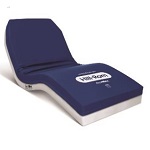
Homecare Support Surfaces and Mattresses
Select Instructions From the List Below
MedExplains AI Content
Homecare Support Surfaces
Homecare support surfaces are products designed to redistribute pressure, reduce friction and shear, and maintain skin integrity for patients at risk of pressure ulcers or other skin conditions. There are several types of support surfaces:
- Static Support Surfaces:
- Foam Mattresses: Made of high-density foam, these mattresses provide basic pressure redistribution. They are available in various thicknesses and densities to accommodate different weights and needs.
- Gel Mattresses: Contain gel-filled sections that help distribute weight evenly and reduce pressure points. They offer good support and cooling properties.
- Alternating Pressure Pads: Consist of air-filled cells that alternate inflation and deflation to change pressure points on the body, reducing the risk of pressure ulcers.
- Dynamic Support Surfaces:
- Low-Air-Loss Mattresses: Use air flow to maintain a cool, dry skin environment. They continuously circulate air to manage moisture and heat, reducing the risk of skin breakdown.
- Alternating Pressure Mattresses: Feature air cells that alternate in pressure, providing continuous pressure redistribution. These are often used for patients with existing pressure ulcers or at high risk for developing them.
- Air Fluidized Beds: Contain microspheres that simulate a fluid state, allowing the patient to float on the surface. These are highly effective for severe pressure ulcers and critical care.
Homecare Mattresses
Homecare mattresses are designed to provide comfort and therapeutic benefits for patients who spend extended periods in bed. These mattresses can include various features to address specific needs:
- Standard Homecare Mattresses:
- Typically made of high-density foam or innerspring construction.
- Offer basic support and comfort for general homecare needs.
- Pressure-Relieving Mattresses:
- Memory Foam Mattresses: Conform to the body’s shape, providing even weight distribution and reducing pressure points.
- Hybrid Mattresses: Combine foam, gel, and/or innerspring technologies to offer enhanced support and pressure relief.
- Specialty Mattresses:
- Bariatric Mattresses: Designed to support higher weight capacities, typically made of reinforced materials and high-density foam.
- Positioning Mattresses: Feature built-in wedges or contours to help position patients in specific ways, which can be useful for respiratory conditions or post-surgery recovery.
- Turn-Assist Mattresses: Include features that assist caregivers in turning and repositioning patients to prevent pressure ulcers and improve comfort.
Key Features and Benefits
- Pressure Redistribution: Both support surfaces and mattresses are designed to reduce pressure on bony prominences, helping to prevent pressure ulcers.
- Moisture Management: Many surfaces incorporate materials or technologies to wick away moisture, keeping the skin dry and reducing the risk of skin breakdown.
- Temperature Control: Some mattresses and support surfaces are designed to maintain a consistent temperature, enhancing comfort and preventing overheating.
- Adjustability: Dynamic support surfaces can be adjusted to meet the specific needs of the patient, providing personalized care and comfort.
- Durability: Homecare mattresses and support surfaces are made from durable materials to withstand regular use and maintain their therapeutic benefits over time.
Maintenance and Care
- Regular Cleaning: Follow manufacturer guidelines for cleaning and disinfecting the surfaces to maintain hygiene and extend the lifespan of the products.
- Inspection: Periodically check for signs of wear and tear, such as foam compression, air leaks, or damaged covers, and replace components as needed.
- Proper Use: Ensure that the mattress or support surface is used according to the manufacturer’s instructions, including weight limits and recommended settings for dynamic surfaces.
By understanding the different types of homecare support surfaces and mattresses, caregivers can select the appropriate products to enhance patient comfort, prevent pressure injuries, and support overall health and well-being.














